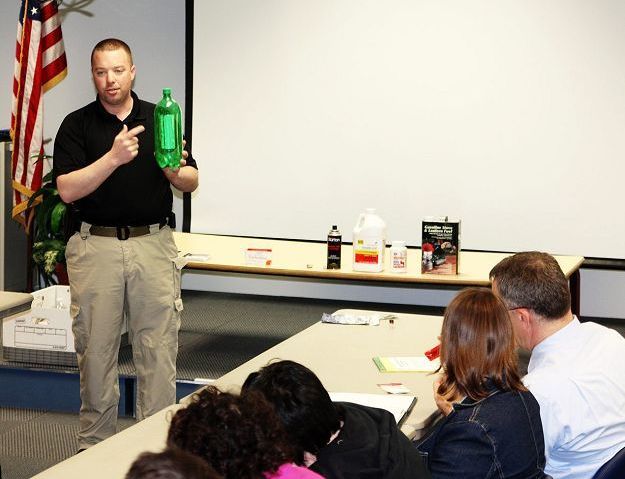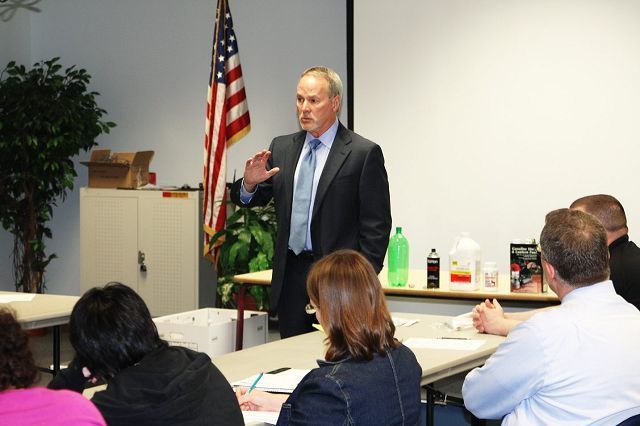HCPC members seek ways to meet growing meth problem head on
It seems as though, with all of the slum areas and dark back alleys in major cities, that those wishing to break the law and produce methamphetamines (meth) could have their pick as to what part of the big city they wanted to try to cook their product.
Yet, what law officials are finding is that it is in small, rural communities like Holmes County that meth labs are cropping up. Holmes County continues to see its fair share of meth labs, and even as area law enforcement agencies crack down, signs point toward the trend of utilizing less populated areas to provide the background for meth makers to flourish.
Were seeing more and more meth labs cropping up in small town everywhere, and Holmes County is no different, and we arent immune to this kind of activity, said Holmes County detective Joe Mullet, who was the keynote speaker at the April 28 meeting of the Holmes County Prevention Coalition (HCPC) at the Holmes County District Public Library. We have seen a trend toward more and more people getting into this, and rural communities are where they have chosen to do it.
Mullet and Holmes County Prosecutor Steve Knowling addressed the HCPC members during the meeting, Mullet talking about how meth is cooked, stored and sold, and Knowling speaking about how the drug is affecting the county.
This area is a hot bed for meth, agreed Knowling. Meth is definitely the biggest drug threat in Wayne and Holmes counties, and it has a strong presence in small communities around the U.S. It is here now, and it has been here for some time, and it isnt likely to go away any time soon.
One of the reasons meth has become such a popular drug of choice for drug dealers is because the process in creating the drug has been simplified, and the products needed to create it can be procured without a great deal of work.
The other driving force, according to Mullet, is the simple fact that there is a high demand for the drug, and wherever there is a demand, someone will be willing to provide the product, no matter how illegal nor how dangerous it may be to produce it. The lure is, according to Mullet, a chance to strike it rich for those who manufacture meth in their homes.
People buy it so people make it, said Mullet. The only way it is going to go away is if there is no more demand for it, and until that happens, people are going to continue to make it.
Mullet had a series of tools of the trade of those cooking meth, as well as several examples of crack cocaine, meth and powder cocaine. He then talked about how meth is created, and the incredible dangers that can result from getting involved with the drug outside of possible incarceration.
Using mostly two-liter Mountain Dew bottles, those producing meth take on a great risk since the concoction can be quite volatile when cooking it. Mullet said that to test the drug, they will oftentimes drive around country roads, toss the two-liter bottles into ditches for several hours and then return once they feel it is safe.
The other issue which has left law enforcement officers on raids awestruck is many of the people producing meth are doing so in the confines of their own homes, with youngsters, toddlers and even infants being put in harms way because of the fumes, which can be equally as addicting as the drug.
The fumes create such a level of danger that whenever officers do perform a raid, they must wear gear designed to protect them from inhaling the fumes. Mullet said that the fumes can begin to deteriorate the lungs within 30 seconds to one minute, and can damage the voice box in a heartbeat.
The fact that these criminals are cooking meth with children around is something that Mullet said has always amazed him. HCPC member Dr. D.J. McFadden, Holmes County health commissioner, agreed, stating, This is just a horrible existence. Adults are in their homes cooking with kids around, and they become exposed to the fumes. They are eventually going to become addicted to it through no choice of their own. Its a very sad situation.
McFadden said that because of the ease with which meth can be cooked in todays society, and with a struggling economic situation on the horizon, chances are good that there will be more and more people opting to chance fate to make a living by developing meth.
In addition to the breathing and addiction consequences, meth also rots the teeth, and causes splotchy sores on the skin, both telltale signs that someone is using meth.
From what Ive been told by users, the sores feel like a bug crawling in under the skin, and they eventually get to the point where they want to dig it out and end up scratching the skin away, said Mullet. It is not a pretty thing, but at some point they become addicted and cant escape.
Meth is affordable to make, can be created in a small confine and is in high demand, and Knowling said that what makes it even more alluring is that no knowledge of chemistry is needed in manufacturing the product.
It takes little to no knowledge of chemistry to produce the stuff, said Knowling. Yet, while people can make it, they have no idea that what they are doing is creating a lifestyle, and everything they do once they get into it points toward simply pursuing their high. Nearly everyone who makes meth tends to use it.
Knowling went on to define the results of being busted for creating meth, noting that there are a number of mandatory sentences that come automatically with cooking and selling meth.
Anyone caught cooking meth receives an automatic three year prison term, and can get a two year term if they have been found in possession of the chemicals needed to create meth with an intent to use them for that purpose. Additional years are mandatory if there is intent to manufacture, if people manufacture in a home with children, if they manufacture within 1,000 feet of a school, or if they have a firearm present.
Knowling said that in many cases, all of these issues end up applying, meaning that criminals who produce meth are facing a mandatory seven or eight year prison term without ever even setting foot in a courtroom. And because these are mandatory, Knowling said there are no laws which can circumvent the law from following through.
We do not bargain away mandatory terms, said Knowling. We may not rehabilitate these criminals, but at least for the next five to eight years, they are off the street.
However, he added that while they put away one set of meth lab owners, because of the demand for the product, rest assured there will be more to replace them.
In addition, Knowling said that those who make and use meth dont just affect themselves, but put others in harms way, whether it is family members, or people driving on byways who have no idea that the person coming at them is high behind the wheel.
So, the question begs, what can be done to curb this problem?
Knowling said it is all education, noting, Kids think they are teflon-proof, but this is a virtual death sentence, because once it happens, it becomes a lifestyle.
The only way we can beat this is by all working together, added Jim Garrett, pharmaceutical diversion investigator with Medway. We need to understand that this is a community problem that affects us all.




